The first time I saw Ina Garten make chicken stock, I was happily surprised because it was exactly how my mom made it. Watching her on that day, I could feel the smell of chicken simmering on the stove for hours.
I think we can all agree that homemade chicken stock is superior to any brand you buy at the grocery store. Packed with fresh ingredients (like vegetables and herbs) and whole chicken, it provides a nice balance of flavor. Plus, you can make it work with whatever vegetables you have on hand.
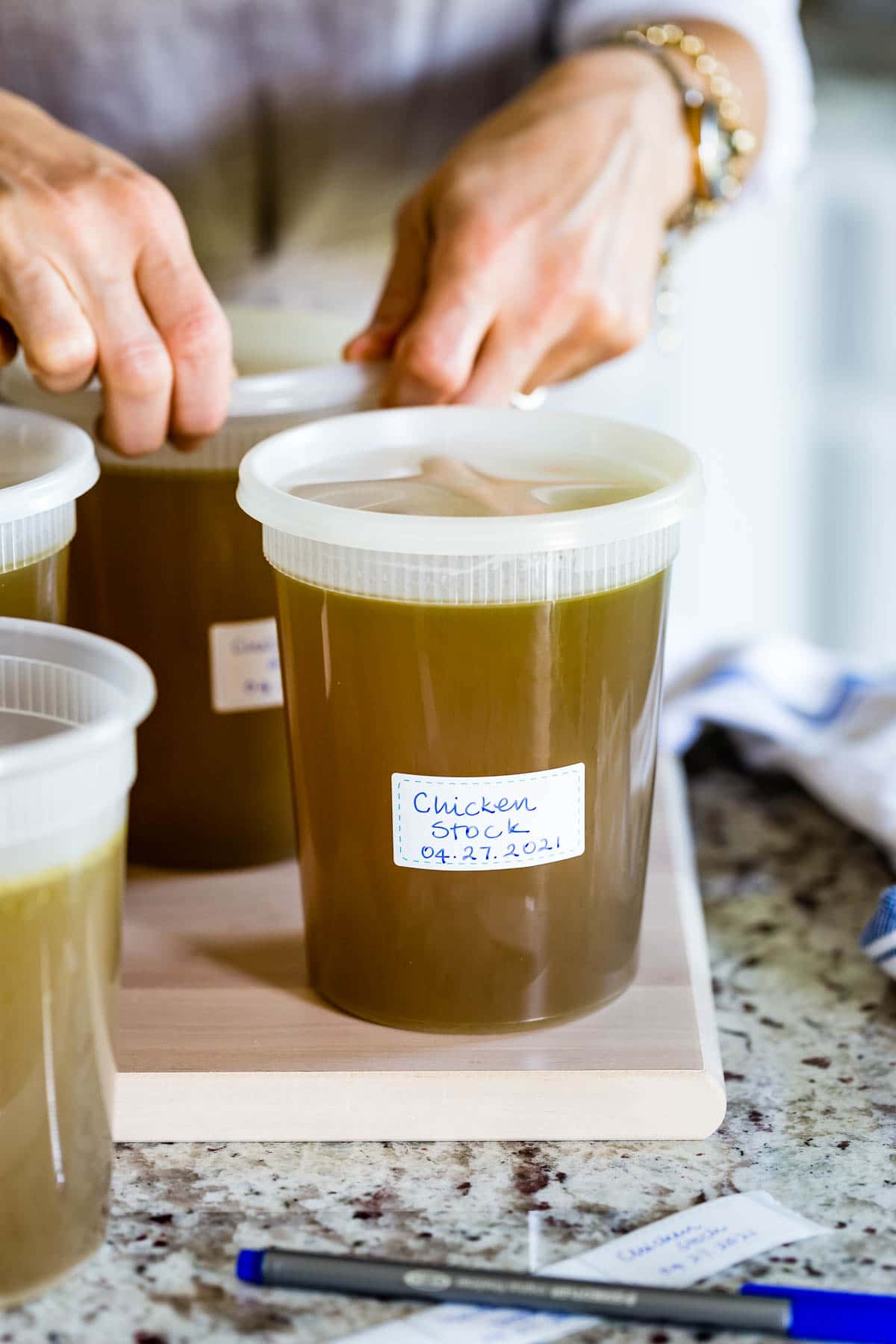
Table of Contents
- Why You Should Make This Recipe
- Ingredient Notes + Substitutions:
- How to Make Chicken Stock from Scratch?
- Helpful Tips On Straining:
- How to Store & Freeze
- What to do with the solids/leftovers?
- 5 Ways To Use Chicken Stock In Recipes:
- Recipe Ideas:
- Tips for Success:
- FAQs
- Equipment Used:
- Ina Garten’s Chicken Stock Recipe
I love to use it as the base for Hearty Chicken and Vegetable Soup, Crockpot Chicken Tomatillo Soup, Chicken Wild Rice Soup, and so much more!
Why You Should Make This Recipe
I like to think of homemade stock as liquid gold. I love it because it’s:
- Taste and quality are far better than anything you will buy in a box.
- Easy to prepare and can simmer on the stove while you’re meal prepping for the week.
- A two-for-one recipe since you can use the leftover chicken and save the scraps, too!
- It can be made with whatever vegetables (or scraps) you have on hand. Take the below recipe for chicken stock as a place to start and adjust it according to what you have in your fridge. More on that below.
Ingredient Notes + Substitutions:
The ingredient list includes medium carrots, celery stalks (with leaves), parsnips (optional), large yellow onions, a whole head of garlic, kosher salt, fresh thyme, fresh parsley, fresh dill, whole peppercorns, roasting chickens, and cold water.
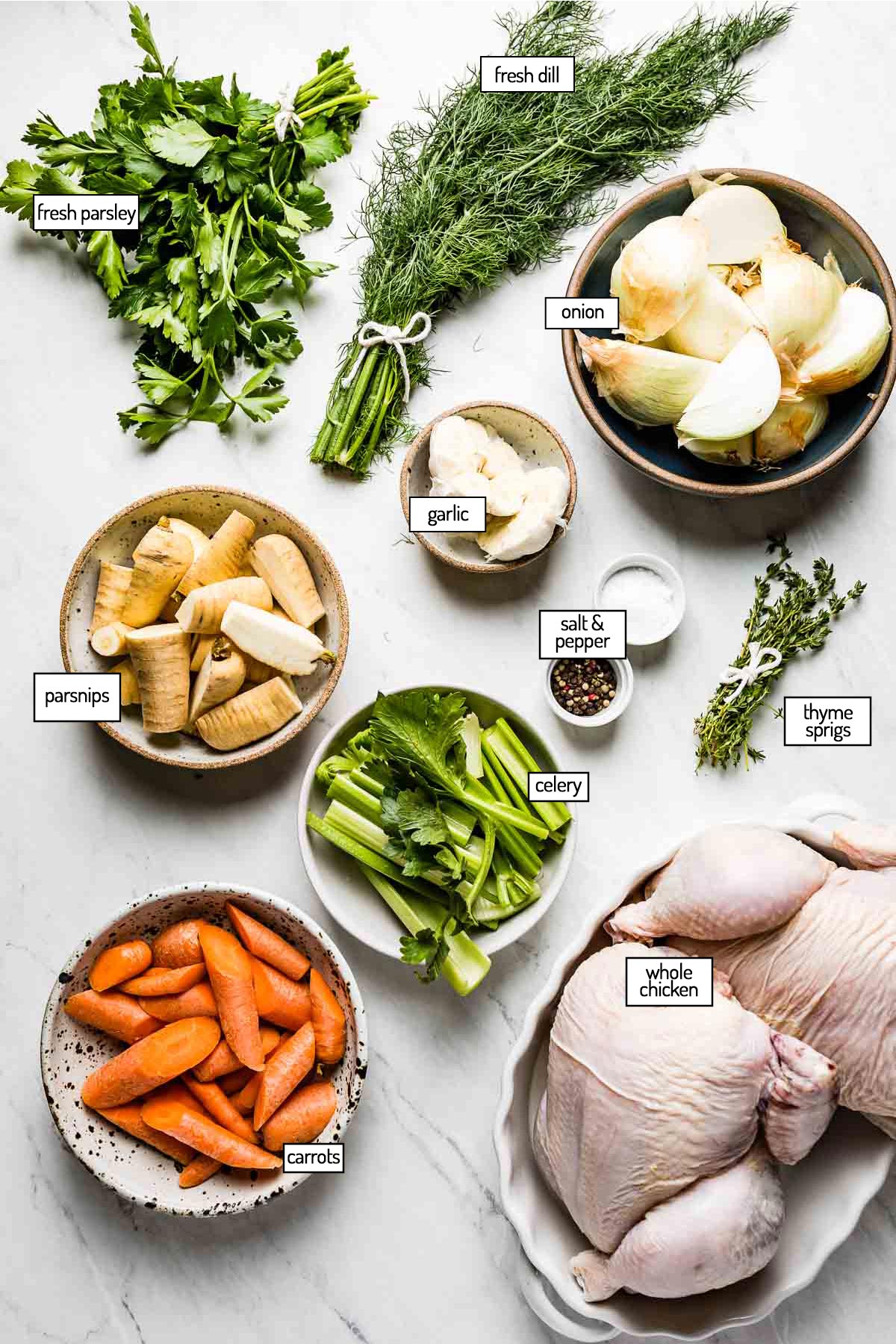
Below are a few helpful notes, including a few substitutions:
- Whole Chicken vs. Chicken Pieces: In her recipe, Ina Garten uses three 5-pound roasting chickens (aka whole chickens) and cooks them in a 16 to 20-quart stockpot (such as this Le Creuset Stock Pot (affiliate link)). If you do not own a stock pot that big, use the largest pot you own. If you do so, use one large (or two smaller) roasting chickens instead. You can also use 7-10 pieces of chicken parts if you prefer.
- Chicken to water ratio: Ina uses 7 quarts of water for three whole chickens. If your stock pot is smaller, I recommend covering the chicken and veggies with water by at least 1-2 inches.
- Do I have to peel vegetables when making chicken stock? No need to peel anything. Like my mom, Ina washes all the veggies under cold tap water, cuts them into large pieces, and adds them to the stockpot. The peels are good for the stock and leave many good things behind, like more flavor, color, and vitamins.
- Spices & Seasoning: Ina uses a combination of black and white peppercorns in terms of spices. She also suggests seasoning the liquid well with 2 tablespoons of Diamond kosher salt (affiliate link).
- Vegetables: While Ina uses carrots, celery, onions, parsnips, and garlic, you can use other vegetables as well. If I have them on hand, I also like to add mushrooms, leeks, shallots, red onion, and one or two bay leaves.
How to Make Chicken Stock from Scratch?
Barefoot Contessa’s chicken stock recipe takes about four hours to make. I like to make it on days when I will be hanging about the house or getting my meal prep together for the week. Simply:

- Place all ingredients in a large pot. (I used a Dutch oven but if you do not have one, use the biggest one you have on hand).
- Add water and bring it to a boil.
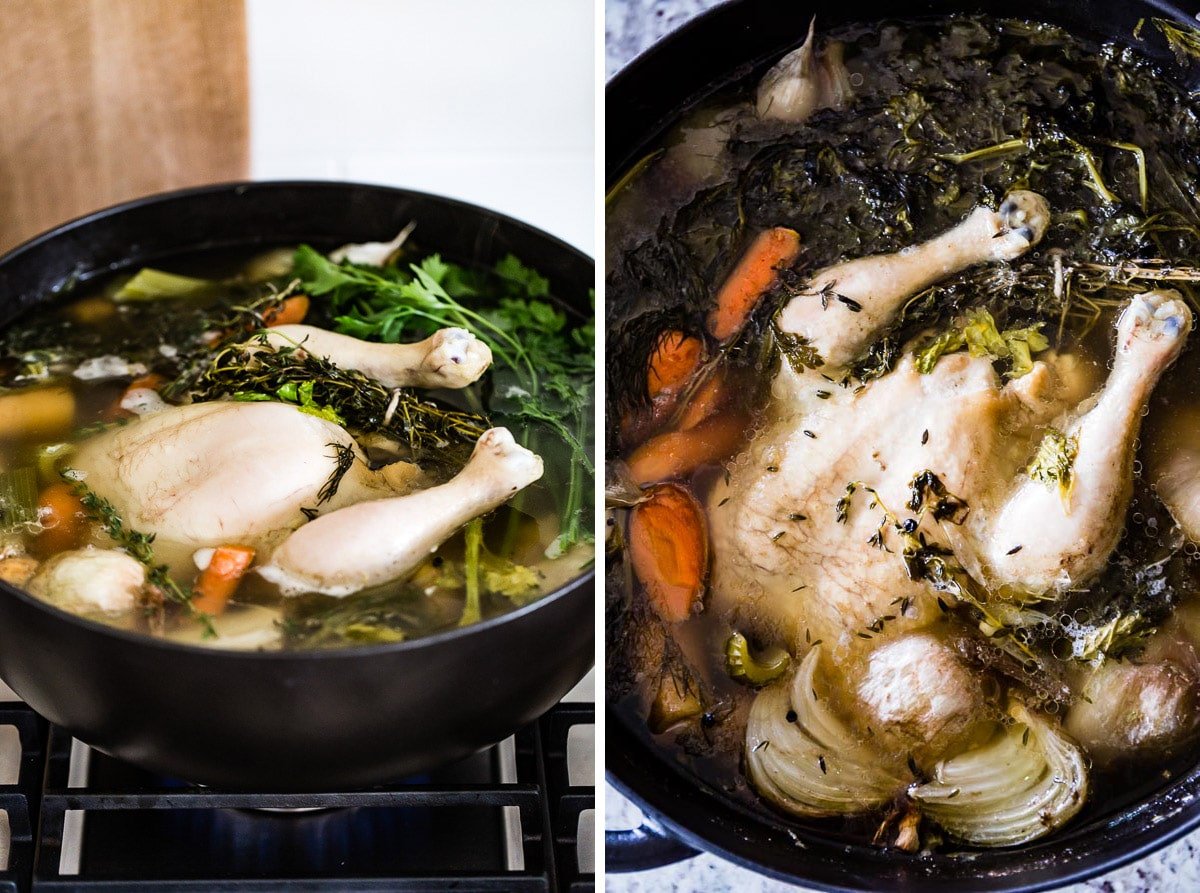
- Turn it down to medium-low heat and simmer it uncovered for 4 hours. Remove the surface fat with a spoon as necessary.
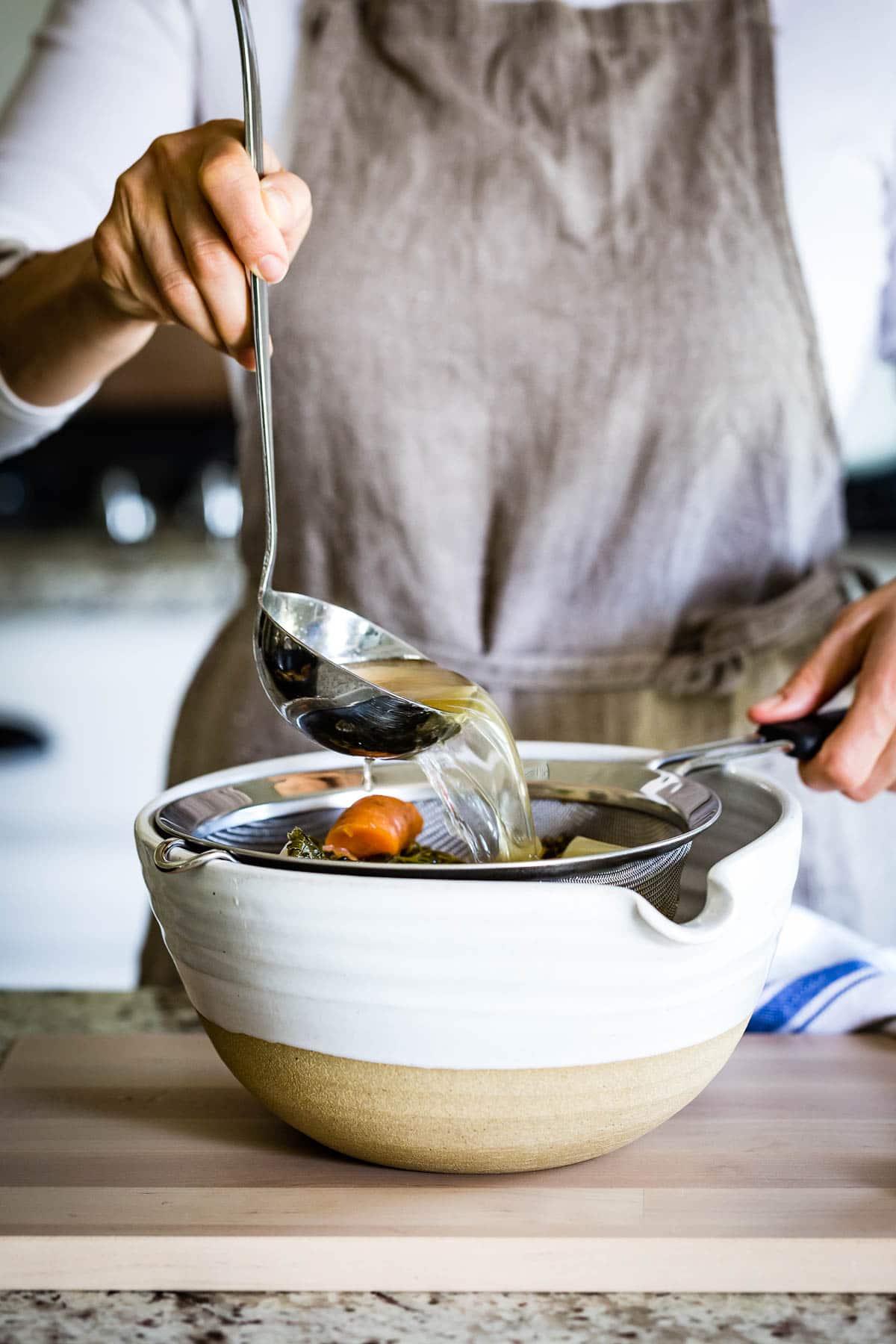
- Strain the entire contents of the pot in batches through a fine-mesh strainer.
- Pack the liquid in airtight containers and refrigerate for a week or freeze up to 4 months.
Helpful Tips On Straining:
Admittedly, the straining part is my least favorite part of making my own chicken stock. If you feel the same way, here are a few ways to make it easier:
- Use a large glass bowl (or a measuring bowl) with an easy pour spout: This makes it so much easier to pour the hot chicken stock into containers later on.
- Put your ladle to use: Remember, the whole thing is still very hot, so it is easier to use a ladle to move the contents of the pot into the container fitted with the strainer.
- Be sure to leave room for expansion in the freezer: As you pour the chicken stock into the airtight containers (I like these 1 quart deli containers), be sure to leave an inch of space at the top for expansion in the freezer.
How to Store & Freeze
- Storage Instructions: Let the chicken stock cool down and then place in the fridge. They will last for 5-7 days in the refrigerator.
- Freezing Instructions: I let them sit in the refrigerator overnight before moving them into the freezer. Once frozen, they should be good for up to 6 months.
- Thawing Instructions: To thaw, place the frozen chicken stock in the fridge the night before. If short on time, the chicken stock can also be thawed in a large bowl of cool water on the kitchen counter.
What to do with the solids/leftovers?
In her recipe, Barefoot Contessa suggests discarding the solids, including the chicken and vegetables. This is the part where I disagree with her.
I can’t get myself to throw away all that cooked chicken and vegetables. Having worked in hotel kitchens in my previous life, I follow in the footsteps of some of the restaurant chefs I worked with and re-use them.
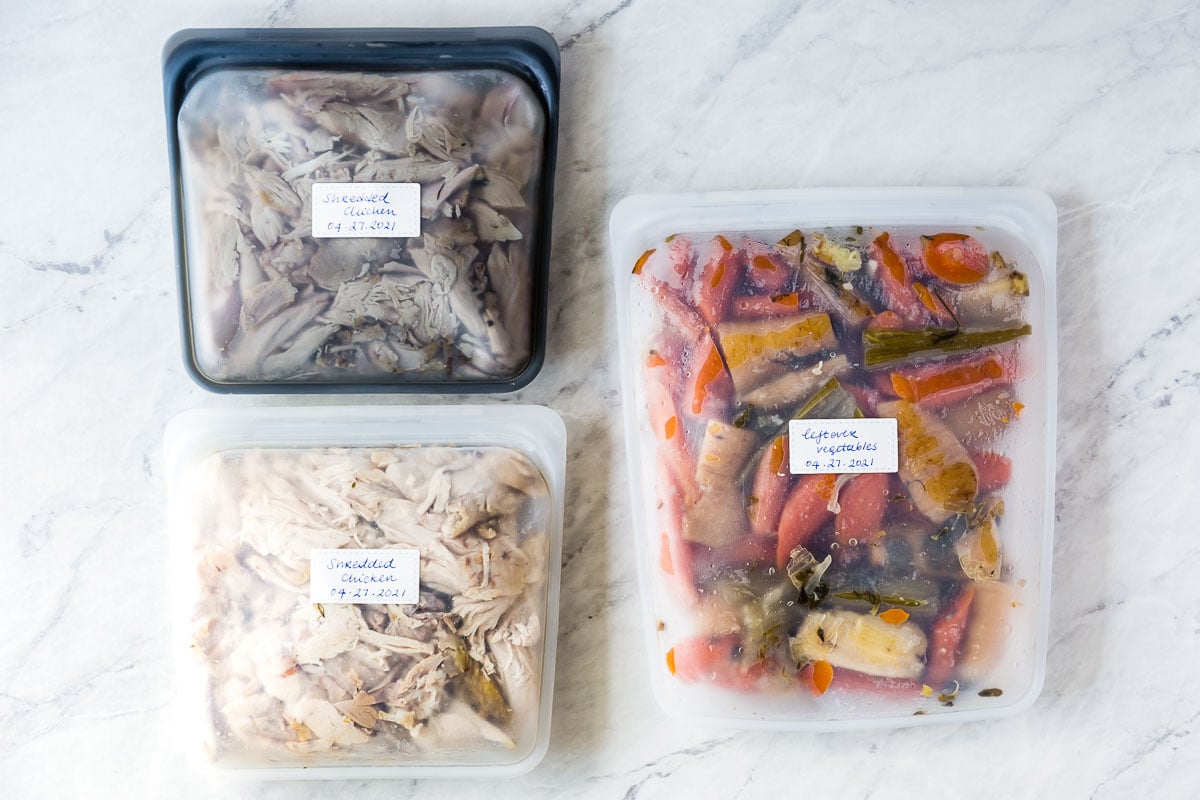
The leftover chicken carcass and vegetables are perfectly okay to use once more to make even more stock when needed. To do so, simply:
- Remove the cooked chicken meat from the bones, shred it into small pieces, freeze or use it in any one of the following recipes (keep reading!).
- Take the cooked chicken bones and leftover veggies, place them in a large plastic freezer bag, label, date and freeze for up to 3 months.
- When ready to use, no need to thaw! Use frozen and make it a part of your next batch of chicken stock. I usually combine it with more raw chicken and veggies to make it super rich and tasty.
5 Ways To Use Chicken Stock In Recipes:
- Use it as a base in homemade soups (like my Lemon Chicken Soup with Orzo and Chicken Noodle Soup with Potatoes) and stews (like my Crock Pot Chicken Stew). Or in any recipe that calls for liquid (as I used in my Chicken Stroganoff recipe)
- Cook grains like wild rice and quinoa in chicken stock (instead of water) to make them even more flavorful.
- Keep it on hand to use as braising liquid when cooking vegetables and meats.
- Substitute chicken stock in place of wine if you prefer not to use alcohol in your cooking.
- Combine it with milk to make bechamel sauce (or roux).
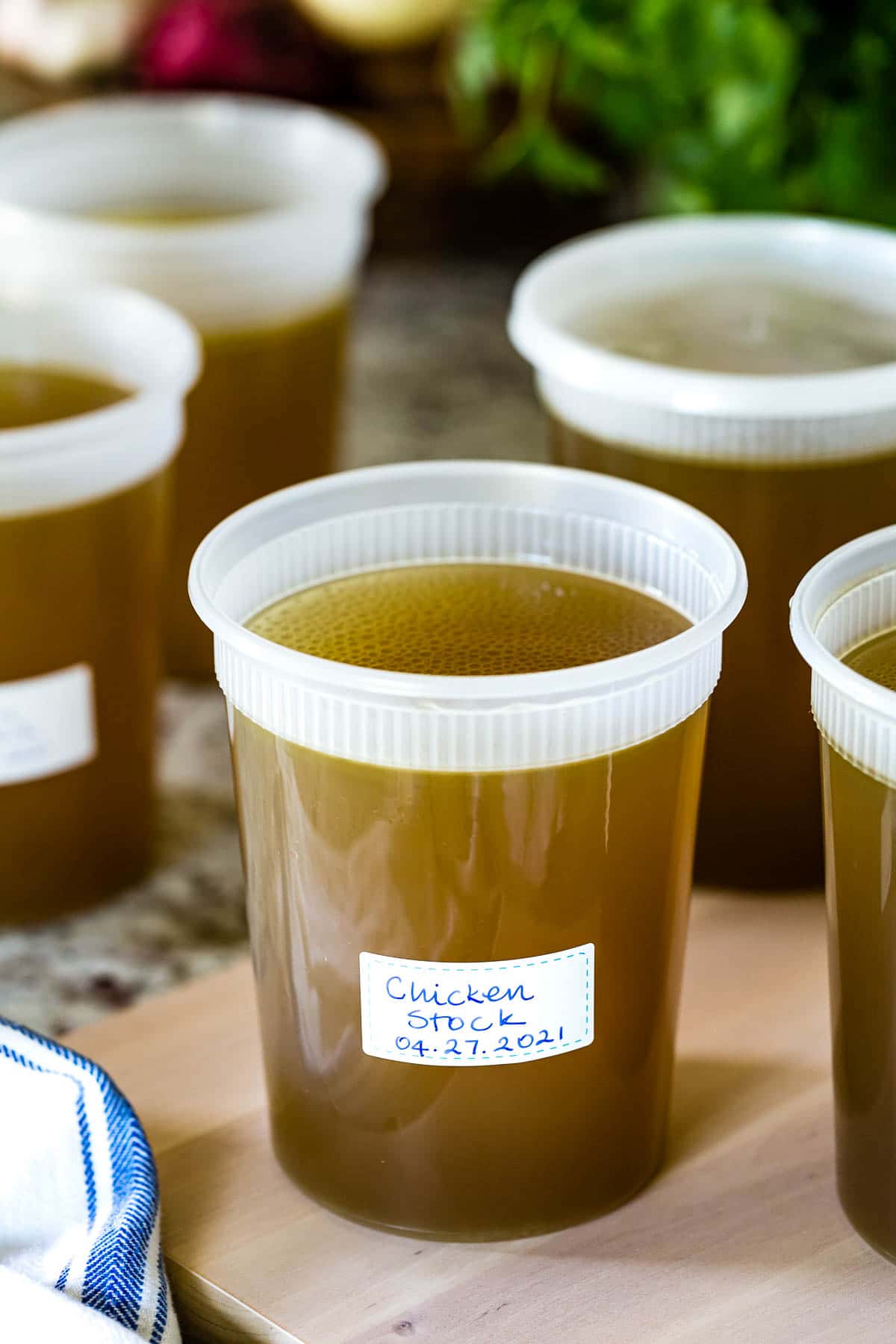
Recipe Ideas:
Now that you are left with some delicious chicken stock and some shredded chicken, here are some chicken recipe ideas to use them in:
- Turkish Pilaf with Chicken
- Chicken Salad with Greek Yogurt
- Sesame Chicken Salad recipe
- Southwest Avocado Chicken Salad
- Low-Calorie White Chicken Chili
- Hearty Chicken and Vegetable Soup
Tips for Success:
- Season well. Ina uses two tablespoons of Diamond Crystal Kosher Salt (affiliate link) to bring out the chicken, vegetable, and herb flavor. I also like to give it a taste once it is cooked. It should taste properly seasoned. If not, stir in ½ teaspoon more and taste again.
- Cool to room temperature first. Strain and pour into individual containers, slightly cover and cool for a few hours or until it is no longer warm. Chill the stock overnight in the fridge before placing it in the freezer on the next day.
- Scrape off the fat, if desired. As it is simmering on the stovetop, you might notice a layer of fat at the top of your chicken stock. If you prefer to get rid of the fat, use a spoon to scrape it off.
FAQs
Chicken stock is made from the meat and the bones, whereas chicken broth is made from the meat (no bones). Because the bones release gelatin and more flavor during cooking, the chicken stock tends to have a richer flavor.
Chicken stock should be simmered, partially covered, on the stovetop for 4 hours.
Equipment Used:
While you don’t need any special equipment to make Ina Garten’s chicken broth, here are a few equipment suggestions that might make your life easier. Please be advised that these are affiliate links:
- 20 quart Stock Pot
- Glass Bowl (or a measuring cup) with an easy pour spout
- Fine Mesh strainer
- Freezer friendly plastic deli containers or if you prefer glass, these Weck jars are ideal for freezing.
This recipe has been adapted from Ina Garten’s, Modern Comfort Cookbook (affiliate link).
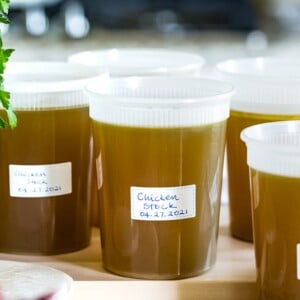
Ina Garten’s Chicken Stock Recipe
Ingredients
- 3 whole chickens*, (4-5 pound each)
- 3 large yellow onions, unpeeled and quartered
- 6 carrots, unpeeled and cut in thirds
- 4 celery stalks with leaves, cut in thirds
- 4 parsnips, unpeeled and cut in thirds (optional)
- 20 fresh parsley sprigs
- 15 fresh thyme sprigs
- 20 fresh dill sprigs
- 1 head garlic, unpeeled and cut in half crosswise
- 2 tablespoons kosher salt
- 2 teaspoons whole black peppercorns
Instructions
- Place the chickens, onion, carrots, celery, parsnip (if using), fresh herbs, garlic, salt and peppercorns in a large 16 to 20 quart stockpot*. Add 7 quarts water.
- Bring it to a boil over medium-high hear. Lower the heat to medium-low and let it simmer (uncovered) for 4 hours.
- Strain in batches using a colander.
- Pour into 1-quart airtight containers. Let them cool down on the kitchen counter for 1-2 hours. Place in the fridge or freeze on the next day.
Video
Notes
- What if I do not have a large stockpot like hers? If you do not have a 16-20 quart stockpot, use the largest one you have. If you do so, you can use 1 large or 2 small whole chickens instead. If you do not have a whole chicken, I would recommend using 7-10 chicken pieces instead.
- What to do with the leftover cooked chicken, chicken bones and vegetables? In her original recipe, Ina Garten suggests discarding them. I prefer to remove the chicken and bones, use shredded chicken in recipes and bones for the next time I make chicken stock. I place them in freezer bags and freeze them in the fridge until I am ready to use them.
- Storage Instructions: Let the chicken stock cool down and then place in the fridge. They will last for 5-7 days in the refrigerator.
- Freezing Instructions: I let them sit in the refrigerator overnight before moving them into the freezer. Once frozen, they should be good for up to 6 months.
- Thawing Instructions: To thaw, place the frozen chicken stock in the fridge the night before. If short on time, the chicken stock can also be thawed in a large bowl of cool water on the kitchen counter.
- Scrape off the fat, if desired. As it is simmering on the stovetop, you might notice a layer of fat at the top of your chicken stock. If you prefer to get rid of the fat, use a spoon to scrape it off.
Nutrition
Nutrition information is automatically calculated, so should only be used as an approximation.
This homemade chicken stock recipe was originally published on May 2013. It has been updated with new photos, information, and recipe in on May 2021.
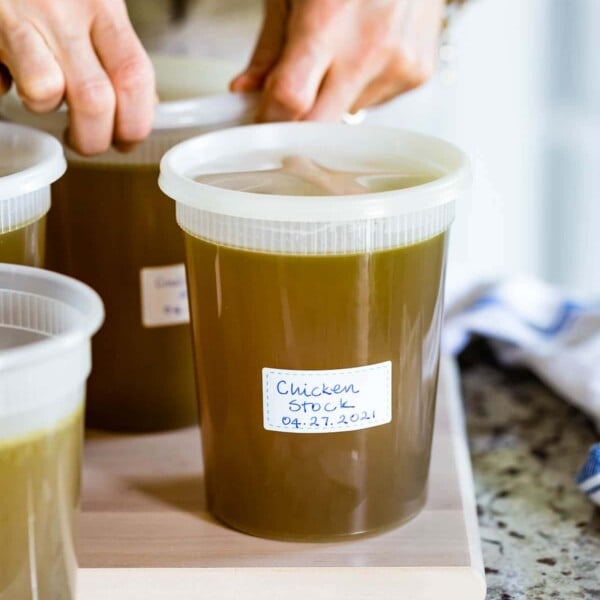
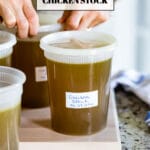

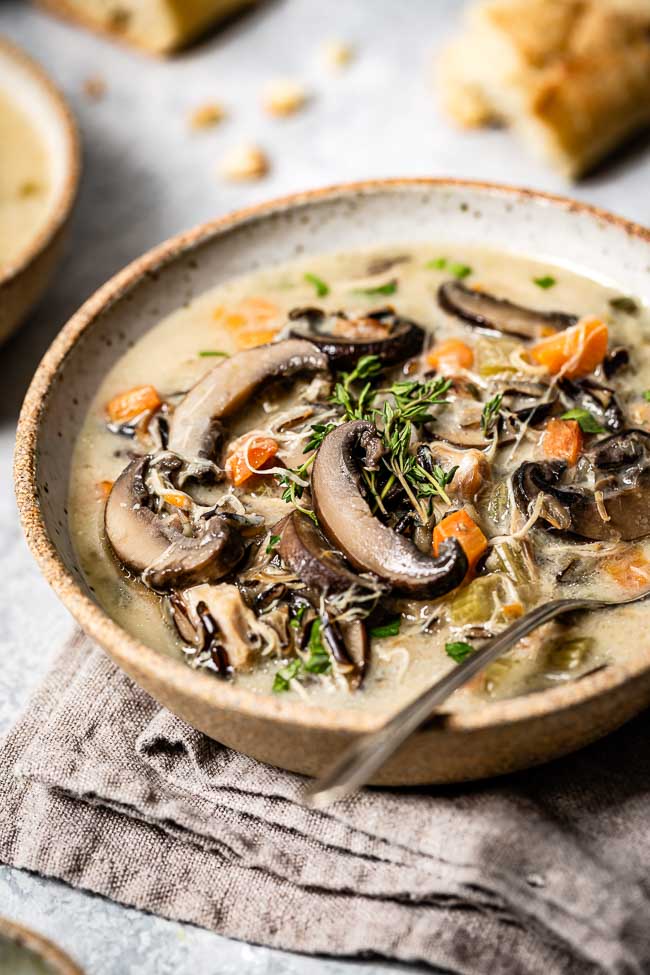











I noticed several people commenting about the chicken meat going to waste in this recipe. To save the meat for another recipe, you can take the chicken out of the stock after two hours of simmering. Let it cool a bit, then remove the meat and refrigerate, freeze or use for your recipe. The bones go back in the stock and simmer another couple of hours.
This is a fantastic tip Rose Ann. Thanks for sharing your knowledge.
Re: inas chicken stock recipe….why is the sodium so high? Only 2tablespoons of salt, how can I lower that number, that’s the reason I wanted to make my own, to make it healthier than store bought. Thank you in advance
Hi Terri,
You can adjust the amount of salt you use based on your taste buds and/or dietary restrictions.
Hope this helps.
Freezing the bones for the next time is such a good idea! Do you cut/break the bones in half though, or do you add them whole? Also: I add a spoon of vinegar in my broth/stock – it partly disolves the bones and make the soup richer!
Hello Jadzia,
I am happy to hear that you found it helpful. I love the idea of adding a spoon of vinegar. I will be sure to try it next time I make my own chicken stock.
To answer your question: I do not break the bones, but you certainly can if you wish to.
I hope this helps.
Hi Ice, thank you for your response! I’m happy you liked the vinegar idea – I thought I should be more clear with what I actually do! I use exactly 1 tablespoon (about 15ml) per 2500ml of water and both me and my husband find it perfect, and I am happy to serve it to my dinner guests! When I started using vinegar, I initially used a teaspoon (5ml) only, but in my opinion it didn’t make any difference. Every next time I used a tablespoon, but last time, for the sake of an experiment, I added 3 tablespoons – there was a strong smell of vinegar in the kitchen for whole duration of cooking (not very pleasant or inviting) and I was scared I messed it all up, but I didn’t – my husband still loved the final result! For me, however, the stock was a bit too strong, and I wouldn’t serve it to my guests. I’m going to stick to 1 tablespoon then. Regarding the moment to add vinegar, some people like to add it in the middle of cooking time, or closer to the end – myself, I add vinegar as soon as water starts boiling. I’ve just discovered your blog, but I share your philosophy and I already noted a few recipes I’m gonna do! Thank you for all your hard work <3
This is very helpful Jadzia. Thanks for sharing your knowledge and experience.
Hello Asyegul,
I totally agree that throwing away the chicken in this recipe is silly. That would be some expensive broth. I noticed that you do not talk about the overcooked vegetables, though.
When I am done making a vegetable broth from vegetable scraps – peels, stalks, etc. – I dry the scraps then I grind them along with some added dried herbs and spices. I call this my savory mix which I put in a used herb or spice jar. I sprinkle it on salad, soups or any savory dish that I have. With the right mix of additions it is delicious and healthful with added fiber and nutrition.
I haven’t made this recipe yet but I will do the same with the leftover veggies.
Thanks for the recipe and all you do.
All great notes. Thanks for sharing your knowledge Joe.
When she says 3-5 pound chickens do I cut them up or leave them hole and how do I get three chickens in a pot. That’s a mighty big pot.
Every other recipes he says cut up and use backbones legs and thighs.
Leanne,
The short and quick answer to your question is that you can use a whole chicken or break it into parts, especially if you do not own a large stock pot. Ina’s original recipe includes 3 large chickens but knowing that not everyone may have a giant stock pot like hers (including myself),I made sure to include suggestions on what equipment to use and how to make it work with a lesser number of chickens within the post. Feel free to refer to it for more information.
I hope this helps.
I covered it for 4 hrs instead of leaving the cover off…now what do i do??
Hello Lori,
I am not sure what your question is. If you follow the recipe, you’ll see that once the chicken and vegetables are cooked you need to strain them.
Is that what you asked? If you can clarify a little bit further I will be more than happy to help further.
Best,
Aysegul
very good idea, thank you
Thank you Magali.
Thank you for this recipe Ice! Can’t believe I thought the organic 365 brand was adequate. I’m shocked that anyone would discard the chicken when so many good meals can be made.
PS – I might mention that it’s best to let the stock cool before storing in plastic containers as they can leach chemicals.
Thank you for all your hard work!
Hi Michele,
I know, that never sounded like something I’d ever would want to do.
Thanks for the tip. You are right, it is imperative that you wait for it to fully cool down before storing it in plastic containers.
Cheers!
I’ve always been really annoyed that Ina’s recipe advises tossing out the chicken after making the stock. Especially when she calls for *3* 5-pound chickens, an amount that can be pretty expensive (like over $50 if you use free-range chicken!!). Thanks for sharing your step-by-step for using up the leftovers. My husband loves to snack on the overcooked vegetables lol.
Oh I am so glad to know that I am not alone. It is so hard for me throw away food with so many people in need.
Thanks for coming by my friend.
Cheers!
Dear Aysegul – I wanted you to know that I have not bought a single pre-made chicken stock since the day I learnt how easy it is to make your own. Homemade chicken stock gives an amazing flavor to dishes without all the added preservatives that come with the store bought versions. Thank you thank you thank you for all the deliciousness you bring to my life! xoxo
Great idea!!